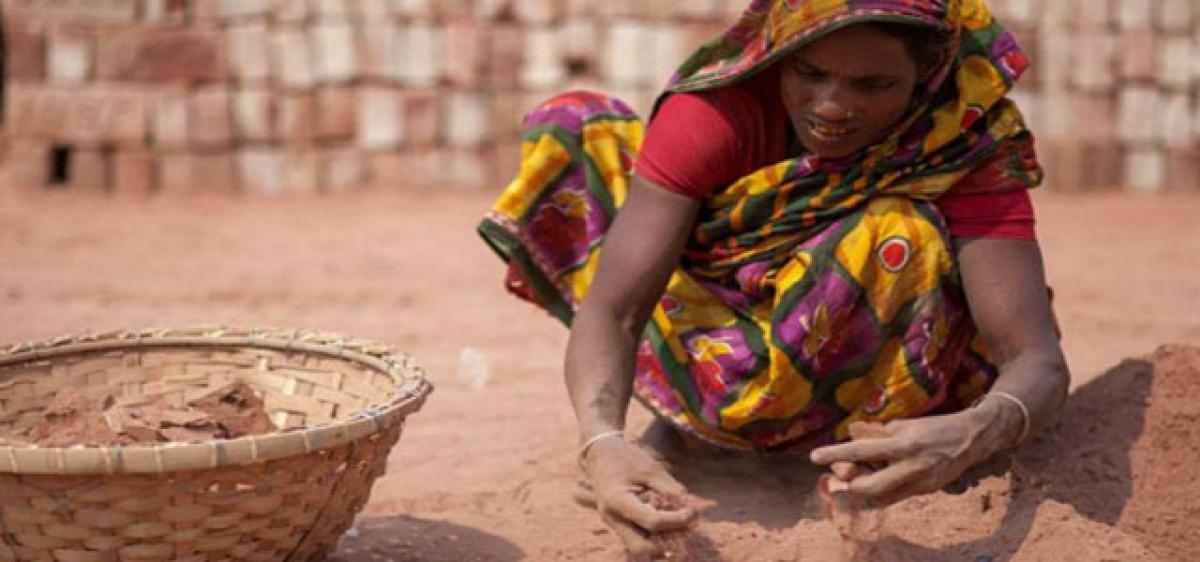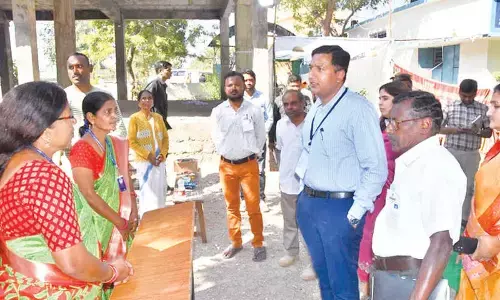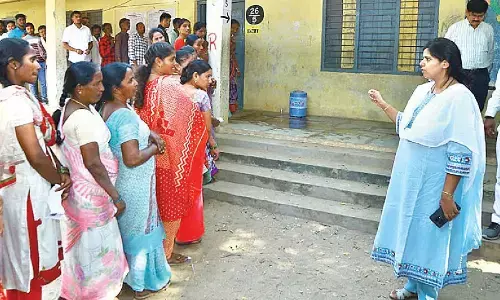Reasons behind stagnating female labour-force participation in India

Globally, about half of all women work, and recent increases in rates of female labour force participation have contributed to a falling gender gap in employment in many countries. Yet, in India, trends in women’s participation in the market economy are moving in the opposite direction.
Globally, about half of all women work, and recent increases in rates of female labour force participation have contributed to a falling gender gap in employment in many countries. Yet, in India, trends in women’s participation in the market economy are moving in the opposite direction.
Despite a rapid fertility transition, broad increases in women’s educational attainment, and substantial economic growth over the past two decades, the share of Indian women working has fallen over time.
Currently, only about one-third of India’s half a billion adult females report being part of the labour force. These low rates of female employment and declining trends in women’s labour force participation rates are potential causes for concern, because market work for women is often associated with their better access to economic opportunities and with greater decision-making power within the household.
From a macroeconomic perspective, low rates of market work among women also imply a significant underutilisation of labour resources in the economy. India in recent decades has enjoyed economic and demographic conditions that ordinarily would lead to rising female labour-force participation rates.
Economic growth has been high, averaging 6-7% in the 1990s and 2000s; fertility has fallen substantially; and female education has risen dramatically, albeit from a low level.
In other regions, including Latin America and the Middle East and North Africa, similar trends have led to large increases in female participation. National Sample Survey (NSS) data for India show that labour force participation rates of women aged 25-54 (including primary and subsidiary status) have stagnated at about 26-28% in urban areas, and fallen substantially from 57% to 44% in rural areas, between 1987 and 2011.Different age groups or different surveys essentially tell the same story, even though the levels differ slightly.
This is despite India enjoying economic and demographic conditions that would ordinarily lead to rising female labour-force participation rates.
What’s the main concern?
- This is an important issue for India’s economic development as India is now in the phase of “demographic dividend”, where the share of working-age people is particularly high, which can propel per capita growth rates through labour force participation, savings, and investment effects.
- But if women largely stay out of the labour force, this effect will be much weaker and India could run up labour shortages in key sectors of the economy.
- Also, there is a wealth of evidence suggesting that employed women have greater bargaining power with positive repercussions on their own well-being and that of their families.
Is India is behaving according to the feminization U hypothesis?
- It is being said that the reason for low female labour-force participation in India is mainly because India is behaving according to the feminization U hypothesis, wherein female labour force participation first declines and then rises.
- The hypothesized mechanisms for the decline are a rising incompatibility of work and family duties as the workplace moves away from home, an income effect of the husband’s earnings, and a stigma against females working outside the home (generally, or in particular sectors).
- The rising portion then comes with a receding stigma, high potential earnings of females as their education improves further, as well as fertility decline, and better options to combine work and family duties.
Contrasting view
According to some experts, India is not behaving according to this hypothesis. They cite the following reasons:
- According to a study, the empirical support for the feminization U hypothesis is feeble at best. There is little support for a U-shape of female participation in the Indian case.
- Also, the U hypothesis cannot explain the vastly different levels of female participation between countries. In India, female labour force participation rates are 22 percentage points below their expected level in a feminization U curve.
What are the reasons for low-participation rate?One possible reason for this is India is behaving according to the feminization U hypothesis.
- According to it, in the development process, female labour force participation first declines and then rises.
- There is a decline in female participation in rural areas is concentrated among married women aged 25-64.
- Rising education, incomes, and husband’s education could account for most of the decline in female labour force this.
- Another reason is that the rising education and incomes are allowing women to get out of menial and undesirable employment, while jobs deemed appropriate for more educated women have not grown commensurately.
- The lack of availability of agricultural and non-agricultural jobs in rural areas appears to be driving the declining participation in rural areas says one study.
- Structural change in India also led to a rapidly shrinking agricultural sector in favour of a rapidly expanding service and construction sector.
- This also mainly contributed to the declining female labour force participation.
Demand and supply-side drivers of female labour participation
- A number of new micro-level studies using NSS data have appeared in the last few years, trying to shed light on this phenomenon, examining labour supply and labour demand factors. Some of them are as follows.
- Using data from 5 National Sample Survey Employment and Unemployment Surveys spanning 1987/88 to 2009/10, reveals surprising stagnation of female labor force participation over the past twenty years
Study 1
- NSSO study, after first showing that the decline in female participation in rural areas is concentrated among married women aged 25-64, then showed that from 1987-2011, rising own education, incomes, and husband’s education could account for most of the decline in female labour force participation in rural areas.
- It also argues that the decline might be driven by increasing returns to home production, relative to market production.
- This might be particularly relevant if the domestic production is childcare.
- While the educated women that drop out indeed report being engaged in home production, the direction of causality is less clear.
- Maybe women drop out of the labour force for other reasons and then report a focus on domestic activities.
- Also, it would be good to test whether this decline of participation occurs particularly among women with children of school-going age.
- NSSO data shows that Labour force participation rates (LFPR) over time by gender and urban/rural area, for the sample of adults aged 25 to 65.
- Men work at substantially higher rates than women, and rural women work at higher rates than urban women.
- Strikingly, rural Indian women experience the largest declines in LFPR over time.
- In 1987, their LFPR was around 55%; by 2011, only 44% were working in the market.
- Data also shows that within the sample of rural women, those who are married drive the overall decline in women’s LFPR.
Study 2
- Analysing data form 1987-2012, the study find a strong income effect, a negative (but over time declining) effect of husband’s education, a U-shaped own-education effect, a negative effect of children, marriage, and the presence of in-laws, and positive effects of access to finance and infrastructure, and access to Mahatma Gandhi National Rural Employment Guarantee Act (MNREGA) employment. Labour demand variables, (imperfectly) proxies by local employment structure, do not display a large impact.
Study 3
- Using data form 1987-2011, this study finds that rising household incomes and husband’s education, falling labour market attachment of highly educated women, as well as adverse development in district-level labour demand, contributed to declines in female participation, while fertility decline and rising own education worked in the opposite direction, to generate a net stagnation.
- More generally, they argue that rising education and incomes are allowing women to get out of menial and undesirable employment, while jobs deemed appropriate for more educated women (especially in healthcare, education and public service) have not grown commensurately with the rise in female education, leading to falling participation among more educated groups.
Study 4
- The study shifts the focus towards labour demand and argues that the lack of availability of agricultural and non-agricultural jobs in rural areas appears to be driving the declining participation in rural areas.
Study 5
- This study focuses on the effect of structural change on female labour force participation using state-level data.
- They find that structural change in India, which led to a rapidly shrinking agricultural sector in favour of a rapidly expanding service and construction sector, mainly contributed to the declining female labour force participation.
- The lack of a shift towards manufacturing and a persistently low female share in manufacturing ensured that the labour force as a whole did not become more female.
- In summary, it appears clear that labour supply factors do play a role in depressing female incomes.
- It is difficult for married women with some education and children to be employed, especially if they have an educated and well-earning spouse.
- But labour demand also matters. Particularly in rural areas, it appears that declining agricultural employment has left a gap in employment opportunities for women as non-agricultural jobs have not emerged at the required pace.
Increasing levels of education are associated with declining rates of female LFP
Changes in female LFPR over time reveal three broad patterns
1.Changes in individual attributes (like increasing education levels and changing age distributions) and household factors (like increases in household wealth and improvements in men’s level of education) fully account for the fall in women’s labour force participation between 1987 and 1999.
2.Changes in these variables account for a much smaller share (just over half) of the decline in LFPR between 1999 and 2011. We do not find strong evidence that observable variables correlated with social stigma against women working outside the home (example, caste, religion) can account for a substantial proportion of the fall in women’s LFPR in either period.
3.Increasing levels of education among rural married women and the men in their households are the most prominent attributes contributing to the decline in LFPR in both decades.
Why should more women’s education contribute to lower rates of LFP?
- The reason is U-shaped relationship between women’s education and their participation in the labour market.
- As women move from being illiterate to having primary and middle levels of schooling, LFPR falls.
- LFPR only start to rise as education increases to completed secondary schooling and to the graduate level.
- Over the last three decades, women in rural India have gained enough education to move younger cohorts from illiteracy to low and middle levels of education.
- But, in contrast to urban areas, schooling in rural areas has not yet expanded enough to pull most women through completed high school or further, into graduate education.
- The Data suggests that human capital improvements may not yet have reached sufficiently high levels for women to earn high enough returns in market work in rural India.
Way ahead
- Many questions remain open. The role of rising female education needs further investigation, as it is not associated with a commensurate rise in labour market attachment.
- Education appears to play other roles. It is suggested that education also plays a role in the marriage market, and it affects productivity of home production.
- The role of policies needs to be investigated more clearly. More micro evidence on the effectiveness of employment policies is crucially necessary.
- Experimental Evidence provides interesting evidence, but more is required here. The role of macro, trade and structural policies also needs to be investigated.
Key notes
- An individual is defined as being employed according to Principal Status, if they engage in the NSS definition of economic activity for a majority of the year. An individual is defined as being employed according to the Subsidiary Status if they engaged in an economic activity for at least 30 days in the 365 days preceding the survey.
- NSSO study also argues that some of the decline in rural areas is due to some rural areas becoming urban but still being classified as rural.
- At a given point of time. Standard labour supply models assume that labour force participation depends on own potential wages, other household income, and other household characteristics. For those who do not work, potential wages tend to be predicted using actual wages of those who work.
- But selection effects imply that actual wages come from a selected sample - those who chose to work - and might not say much about the potential wages or those who did not. Controlling for this selection effect requires instrumental variables which are hard to find and controversial.
- The NSSO study attempts to estimate own wage effects but it is not clear how the selection issue in the predicted wage equation is tackled.
- To estimate the income effect one needs a proxy for the incomes earned by other household members. Using expenditure as a proxy is problematic. In households where females work expenditures will be higher because of her contribution to household income. So it is not a good proxy for others’ household income, but of total household income.
Conclusion
- India has experienced large improvements in levels of education, falling fertility rates, and increasing incomes across the income distribution since the late 1980s.
- Somewhat surprisingly in this context, rural women in India have removed themselves from the labour market at increasing rates over time.
- An analysis suggests that increasing levels of education for men and women have an important factor accounting for this decline.
- Part of understanding why this is the case is related to the observation that women with medium levels of education choose to do more domestic work, and spend more time on child care and home production.
- Overall, the descriptive analysis suggests that, relative to urban women, rural women in India may still be on the downward sloping part of the U-shaped curve of female LFP.
- Unlocking the potential of women definitely requires an increase and shift in the composition of overall employment opportunities as well as questioning of societal strictures.
- As the country commends itself on world-leading economic growth and aspires towards a $20 trillion economy, it becomes necessary to take women along to make this goal a reality.
- Societal change will be the largest needle mover, but a constant push through the government, organizations and individuals is critical to bend societal norms for the better.














